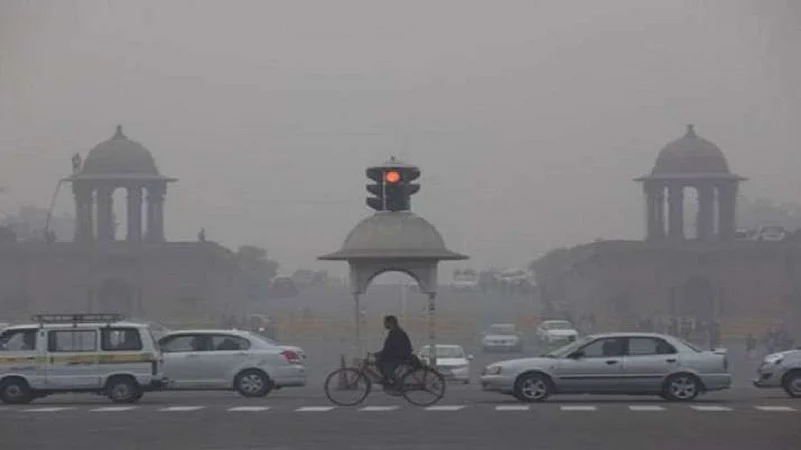Delhi recorded the worst air quality in the country on Wednesday, with pollution levels plunging into the 'severe' category in more areas of the national capital than the previous day.
A thick layer of smog shrouded the Delhi-National Capital Region during the morning and evening hours, worsening the air quality in the region.
In the country, the 24-hour average air quality index recorded at 4 pm was the highest in Delhi at 364, followed by Rajasthan's Dausa with 316 and Ghaziabad with 305, Central Pollution Control Board (CPCB) data showed.
The air quality in Delhi's Anand Vihar, Bawana, Jahangirpuri and Vivek Vihar was recorded in the 'severe' category on Wednesday. On Tuesday, the AQI was 'severe' only in Anand Vihar.
Advertisement
Air quality is classified under four different stages: Stage I – 'Poor' (AQI 201-300); Stage II – 'Very Poor' (AQI 301-400); Stage III – 'Severe' (AQI 401-450); and Stage IV – 'Severe Plus' (AQI>450).
Dwarka, Rohini, DTU, IGI Airport (T3), ITO, Mundka, Narela, Patparganj, Shadipur, Sonia Vihar, Wazirpur, Alipur, Ashok Vihar, Aya Nagar, Burari, Mandir Marg, Jawaharlal Nehru Stadium, Najafgarh and Nehru Nagar were among 24 areas of the national capital where the AQI was in the 'very poor' category on Wednesday.
However, the air quality in neighbouring Faridabad, Noida, Gurugram, Meerut and Greater Noida remained slightly better, in the 'poor' category.
Advertisement
The PM2.5 level was recorded at an alarming 157 micrograms per cubic metre at 7 pm, according to the CPCB.
PM2.5 refers to fine inhalable particles with diameters generally measuring 2.5 micrometres and smaller, posing the greatest risk to health. The acceptable annual standard for PM 2.5 is 40 micrograms per cubic metre.
During the winter months, Delhi experiences severe pollution, driven by a combination of factors such as low wind speeds, dropping temperatures, high moisture levels and the presence of pollution particles that act as surfaces for condensation.
Meanwhile, the deteriorating air quality in the national capital has triggered a 30-40 per cent surge in respiratory issues, with children and the elderly found to be the most vulnerable.
Health experts have advised people to avoid stepping outside and minimise exposure to dust.
Arunesh Kumar, senior consultant in respiratory medicine at Paras Health in Gurugram, said, "We are seeing a sharp increase in respiratory cases, with hospitals reporting a 30-40 per cent rise."
"This surge is largely driven by worsening air pollution, with pollutants such as PM2.5, PM10 and nitrogen dioxide (NO2) getting trapped due to colder weather and stagnant air," he added.
Delhi Lieutenant Governor VK Saxena wrote to Chief Minister Atishi, citing road dust as the biggest contributor to air pollution in the city and suggesting that it would be better to set one's own house in order rather than blaming others.
Advertisement
Amid the deteriorating air quality rising pollution and toxic froth in the Yamuna river in Delhi, ruling AAP leaders have blamed the BJP-ruled Haryana and Uttar Pradesh for the mess.
Citing studies and his own experience of visiting various localities of the city, Saxena claimed in his letter that about 36 per cent of the air pollution in the city is due to dust on the roads and that is caused by unprocessed construction and demolition waste.
Earlier on Wednesday, Environment Minister Gopal Rai said he had written to the central government, reiterating his request to convene a meeting of all stakeholders to approve a cloud seeding proposal to artificially induce rain to combat air pollution in Delhi.
Advertisement
In his letter to Union Environment Minister Bhupender Yadav, Rai emphasised the need for emergency measures, including cloud seeding, to mitigate the health risks posed by hazardous smog and pollution levels.
The BJP demanded Rai's resignation, accusing him of prioritising the "political interests" of the Punjab government over the pollution-related health concerns of Delhi residents.
Delhi BJP president Virendra Sachdeva, in a post on X, asked Rai to either demand accountability from the Punjab government on stubble burning or resign.
Sachdeva claimed that Punjab continued to be the largest contributor to stubble burning in north India.
On Wednesday, factors that contributed to Delhi's pollution on a high margin included transportation, stubble burning, dust pollution and others.
Advertisement
Emissions from transportation accounted for approximately 13.5 per cent of Delhi's air pollution, according to the Centre's Decision Support System for Air Quality Management.
Experts, however, said the AQI is unlikely to enter the 'severe' category until the second week of November as temperatures have not started declining yet and the wind speeds have not slowed down.
Mahesh Palawat of Skymet Weather Services, a private forecaster, said until a strong western disturbance or snowfall hits regions like Himachal Pradesh and Uttarakhand, the temperature will remain stable for at least another week, he said, adding that pollution levels will rise further when temperatures start dropping.
Advertisement
Anti-pollution restrictions under the Graded Response Action Plan (GRAP)-II came into force on Tuesday.
The Delhi government has announced that 1,800 additional traffic personnel would be deployed at 97 congestion points across the city.















 Just one email a week
Just one email a week